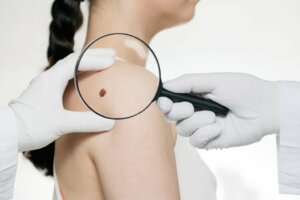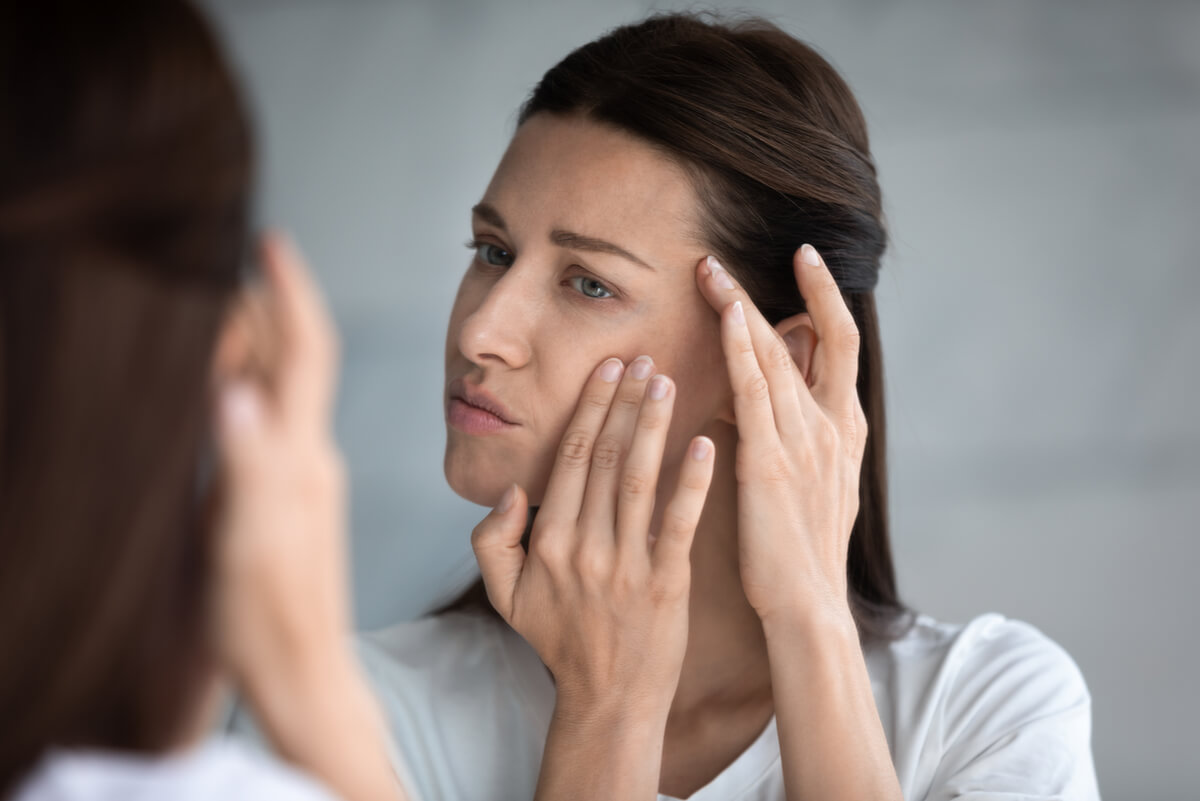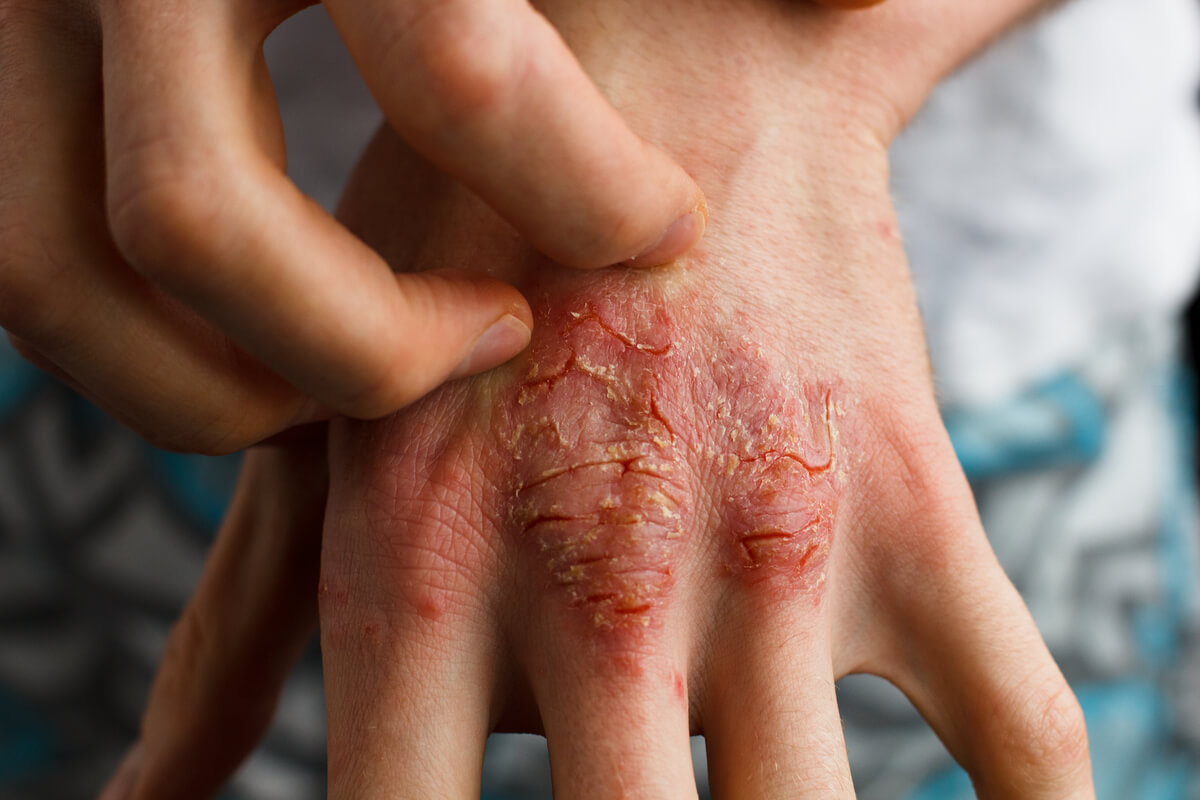Symptoms of Skin Cancer

Skin cancer is one of the most common neoplastic pathologies in the world. It has several forms of presentation and can manifest itself in different parts of the body. Are you interested in knowing what the symptoms of skin cancer are? Next up we’ll tell you.
Skin neoplasms usually appear as warts, moles or new spots that can alarm us. These lesions can vary in shape, thickness and color according to the type of cancer. The progression of this pathology can lead to metastasis in other organs, so early identification and timely management is vital.
Common symptoms of skin cancer

Currently, basal cell and squamous cell carcinoma are the most common skin neoplasms. For its part, melanoma is the third most frequent form, accounting for more than 132,000 cases per year according to the World Health Organization (WHO).
It’s important to know that not all skin changes are considered a defining sign of cancer. However, it’s necessary to seek professional help before the appearance of injuries in any part of the body or the exacerbation of existing ones.
In this sense, some of the symptoms that guide the early diagnosis of skin cancer are the following:
Abnormal spots on the skin
The appearance or development of spots on the skin is usually one of the first symptoms of cancer. These manifestations are generally superficial, asymmetrical, and with irregular borders. Studies suggest that 30% of basal cell carcinomas manifest as slow-growing pink, pearly, or reddish spots.
On the other hand, squamous cell carcinoma usually begins as a reddish spot that is later covered with scales and crusts. This especially in areas of the body exposed to the sun, such as the face, neck, arms and legs. In addition, the spots may have a brown or blackish hue and point towards a possible melanoma.
Ulcers that don’t heal
In most cases, the doctor first rules out a sting, traumatic injury, or vascular disorder when there’s an ulcer or sore. However, the permanence or recurrence of these lesions over time can be considered as an indicative symptom of skin cancer.
Some research states that ulcers that don’t heal are very likely to be found in squamous cell and basal cell cancers. They’re usually evident on the nose, ears, lower lip or hands. In addition, they may be accompanied by areas of raised, reddish or yellowish, shiny, and scabbed skin.
Changes in existing injuries
Skin cancer usually arises from existing lesions in a large proportion of patients. Increased size, color change, and discharge from moles, spots, or other lesions often indicate the presence of a neoplastic condition.
In squamous cell and basal cell cancer, these changes are usually slow, so they go unnoticed. However, most malignant melanomas rapidly progress from dysplastic nevi or moles (those with structural changes in their cells).
Sensitivity alterations associated with a skin lesion
It’s rare for people to have any alteration in sensitivity associated with a skin lesion of any other etiology. However, in skin cancer lesions, sensations such as tingling, swelling, burning, and itching or pruritus may be evident. In fact, some patients experience persistent pain in the affected area.
Rare symptoms of skin cancer
Skin neoplasms can, on rare occasions, show non-subjective symptoms of cancer. Usually, this is related to disease in other areas of the body apart from the skin, or to a rare type of cancer.
However, the presence of these manifestations, in association with those already mentioned, helps doctors diagnose this condition.
Dark lines on the nails
In subungual melanoma, small linear dark spots can be found under the nails or on the cuticle. Skin cancer should be suspected when this symptom appears spontaneously, without any preceding trauma. Some studies suggest that this form of cancer is responsible for 1% of melanomas in the UK.
Visual disturbances
Vision changes, such as double or blurred vision, can point to the presence of an ocular melanoma. Research affirms that the uvea is the area where more than 82% of this type of melanomas develop. In addition, it’s possible to suffer from photophobia (intolerance to light), loss of peripheral vision, and spots in the sclera of the eye.
Strange scars on the skin
Despite what most people expect, not all skin cancers appear as conspicuous bumps or lesions. Basal cell carcinoma sometimes appears as a scar-shaped depression on the skin.
These cancerous lesions appear spontaneously and aren’t related to previous traumas or injuries.
Rashes and red patches on the skin

In T-cell lymphoma, reddish rashes and plaques may appear accompanied by severe itching and inflammation. These lesions are often mistaken for eczema, psoriasis, or some type of superficial mycosis. They usually appear on the buttocks, groin, hips, and armpits.
Inflammation of the breast tissue
The presence of an apparently benign eczematous rash on the skin of the breast shouldn’t go unnoticed. It may be related to the metastatic spread of underlying breast cancer. This condition is known as Paget’s disease and must be addressed immediately.
Melanoma symptoms
Although melanoma isn’t as common as other forms of skin cancer, it evolves rapidly and its malignancy potential is greater. However, early identification and proper treatment offer a good prognosis for most patients.
Changes in moles are often the main warning signs of this condition. The Center for Disease Control and Prevention (CDC) recommends following the following guidelines for the early detection of melanomas:
- A: Evidence of an asymmetric mole, in which both halves are uneven.
- B: The presence of irregular, notched or blurred edges.
- C: Black, brown, or tan-colored lesions, as well as red, gray, white, or blue areas.
- D: Moles larger than a pea or pencil eraser.
- E: The unfavorable evolution of a pre-existing lesion, with changes in its size, thickness, texture, shape, and color.
Possible complications
Skin cancer is linked with a wide variety of complications. In basal cell and squamous cell cancer, complications are often associated with local tumor development.
However, in melanoma there are local and systemic complications, metastasis being one of the most worrisome. Among the main complications associated with skin cancer are the following:
- Infections: These can range from folliculitis to cellulitis or sepsis with multi-organ injury. Cancer treatment can influence the depression of the immune system and favor these infections.
- Lymphedema: This is the increase in size of a certain part of the body, generally a member, secondary to the blockage or damage of the area of lymphatic drainage. In most cases, it occurs due to surgical removal of the lymph nodes. However, it can be the result of metastatic extension.
- Disfigurement: Extensive and deep neoplasms in the skin are associated with extensive scars and loss of facial features. This situation is uncommon in the early approach to the disease.
- Depressive or anxiety disorders: The presence of an obvious lesion on the skin can affect mood and influence people’s self-esteem and psyche. For this reason, a protocol for psychological care is vital in these patients.
- Recurrence: Non-melanoma skin neoplasms can recur at the initial area of the disease after treatment is completed. Melanomas can come back in the same place or in other parts of the body.
- Metastasis: In advanced forms of the disease, it may extend to other organs and tissues. This fact can alter the structure and normal functioning of the human body. The most affected organs are the lymph nodes, bones, lungs, liver, and brain.
When to seek medical assistance?
In general, skin neoplasms have a good prognosis and evolution if diagnosed in the early stages. So seek medical attention as soon as possible if any of the skin cancer symptoms mentioned above occur.
The dermatologist can provide the necessary assistance, evaluate the area, and indicate the most appropriate diagnostic and therapeutic approach.
It’s important to monitor any spots, moles or nevus that seem to change in any way. The prevention of skin cancer involves a healthy lifestyle, avoiding excessive exposure to sunlight, and regular skin monitoring by a specialist.
Skin cancer is one of the most common neoplastic pathologies in the world. It has several forms of presentation and can manifest itself in different parts of the body. Are you interested in knowing what the symptoms of skin cancer are? Next up we’ll tell you.
Skin neoplasms usually appear as warts, moles or new spots that can alarm us. These lesions can vary in shape, thickness and color according to the type of cancer. The progression of this pathology can lead to metastasis in other organs, so early identification and timely management is vital.
Common symptoms of skin cancer

Currently, basal cell and squamous cell carcinoma are the most common skin neoplasms. For its part, melanoma is the third most frequent form, accounting for more than 132,000 cases per year according to the World Health Organization (WHO).
It’s important to know that not all skin changes are considered a defining sign of cancer. However, it’s necessary to seek professional help before the appearance of injuries in any part of the body or the exacerbation of existing ones.
In this sense, some of the symptoms that guide the early diagnosis of skin cancer are the following:
Abnormal spots on the skin
The appearance or development of spots on the skin is usually one of the first symptoms of cancer. These manifestations are generally superficial, asymmetrical, and with irregular borders. Studies suggest that 30% of basal cell carcinomas manifest as slow-growing pink, pearly, or reddish spots.
On the other hand, squamous cell carcinoma usually begins as a reddish spot that is later covered with scales and crusts. This especially in areas of the body exposed to the sun, such as the face, neck, arms and legs. In addition, the spots may have a brown or blackish hue and point towards a possible melanoma.
Ulcers that don’t heal
In most cases, the doctor first rules out a sting, traumatic injury, or vascular disorder when there’s an ulcer or sore. However, the permanence or recurrence of these lesions over time can be considered as an indicative symptom of skin cancer.
Some research states that ulcers that don’t heal are very likely to be found in squamous cell and basal cell cancers. They’re usually evident on the nose, ears, lower lip or hands. In addition, they may be accompanied by areas of raised, reddish or yellowish, shiny, and scabbed skin.
Changes in existing injuries
Skin cancer usually arises from existing lesions in a large proportion of patients. Increased size, color change, and discharge from moles, spots, or other lesions often indicate the presence of a neoplastic condition.
In squamous cell and basal cell cancer, these changes are usually slow, so they go unnoticed. However, most malignant melanomas rapidly progress from dysplastic nevi or moles (those with structural changes in their cells).
Sensitivity alterations associated with a skin lesion
It’s rare for people to have any alteration in sensitivity associated with a skin lesion of any other etiology. However, in skin cancer lesions, sensations such as tingling, swelling, burning, and itching or pruritus may be evident. In fact, some patients experience persistent pain in the affected area.
Rare symptoms of skin cancer
Skin neoplasms can, on rare occasions, show non-subjective symptoms of cancer. Usually, this is related to disease in other areas of the body apart from the skin, or to a rare type of cancer.
However, the presence of these manifestations, in association with those already mentioned, helps doctors diagnose this condition.
Dark lines on the nails
In subungual melanoma, small linear dark spots can be found under the nails or on the cuticle. Skin cancer should be suspected when this symptom appears spontaneously, without any preceding trauma. Some studies suggest that this form of cancer is responsible for 1% of melanomas in the UK.
Visual disturbances
Vision changes, such as double or blurred vision, can point to the presence of an ocular melanoma. Research affirms that the uvea is the area where more than 82% of this type of melanomas develop. In addition, it’s possible to suffer from photophobia (intolerance to light), loss of peripheral vision, and spots in the sclera of the eye.
Strange scars on the skin
Despite what most people expect, not all skin cancers appear as conspicuous bumps or lesions. Basal cell carcinoma sometimes appears as a scar-shaped depression on the skin.
These cancerous lesions appear spontaneously and aren’t related to previous traumas or injuries.
Rashes and red patches on the skin

In T-cell lymphoma, reddish rashes and plaques may appear accompanied by severe itching and inflammation. These lesions are often mistaken for eczema, psoriasis, or some type of superficial mycosis. They usually appear on the buttocks, groin, hips, and armpits.
Inflammation of the breast tissue
The presence of an apparently benign eczematous rash on the skin of the breast shouldn’t go unnoticed. It may be related to the metastatic spread of underlying breast cancer. This condition is known as Paget’s disease and must be addressed immediately.
Melanoma symptoms
Although melanoma isn’t as common as other forms of skin cancer, it evolves rapidly and its malignancy potential is greater. However, early identification and proper treatment offer a good prognosis for most patients.
Changes in moles are often the main warning signs of this condition. The Center for Disease Control and Prevention (CDC) recommends following the following guidelines for the early detection of melanomas:
- A: Evidence of an asymmetric mole, in which both halves are uneven.
- B: The presence of irregular, notched or blurred edges.
- C: Black, brown, or tan-colored lesions, as well as red, gray, white, or blue areas.
- D: Moles larger than a pea or pencil eraser.
- E: The unfavorable evolution of a pre-existing lesion, with changes in its size, thickness, texture, shape, and color.
Possible complications
Skin cancer is linked with a wide variety of complications. In basal cell and squamous cell cancer, complications are often associated with local tumor development.
However, in melanoma there are local and systemic complications, metastasis being one of the most worrisome. Among the main complications associated with skin cancer are the following:
- Infections: These can range from folliculitis to cellulitis or sepsis with multi-organ injury. Cancer treatment can influence the depression of the immune system and favor these infections.
- Lymphedema: This is the increase in size of a certain part of the body, generally a member, secondary to the blockage or damage of the area of lymphatic drainage. In most cases, it occurs due to surgical removal of the lymph nodes. However, it can be the result of metastatic extension.
- Disfigurement: Extensive and deep neoplasms in the skin are associated with extensive scars and loss of facial features. This situation is uncommon in the early approach to the disease.
- Depressive or anxiety disorders: The presence of an obvious lesion on the skin can affect mood and influence people’s self-esteem and psyche. For this reason, a protocol for psychological care is vital in these patients.
- Recurrence: Non-melanoma skin neoplasms can recur at the initial area of the disease after treatment is completed. Melanomas can come back in the same place or in other parts of the body.
- Metastasis: In advanced forms of the disease, it may extend to other organs and tissues. This fact can alter the structure and normal functioning of the human body. The most affected organs are the lymph nodes, bones, lungs, liver, and brain.
When to seek medical assistance?
In general, skin neoplasms have a good prognosis and evolution if diagnosed in the early stages. So seek medical attention as soon as possible if any of the skin cancer symptoms mentioned above occur.
The dermatologist can provide the necessary assistance, evaluate the area, and indicate the most appropriate diagnostic and therapeutic approach.
It’s important to monitor any spots, moles or nevus that seem to change in any way. The prevention of skin cancer involves a healthy lifestyle, avoiding excessive exposure to sunlight, and regular skin monitoring by a specialist.
- Castañeda Gameros P, Eljure Téllez J. El cáncer de piel, un problema actual. Revista de la Facultad de Medicina de la UNAM. 2016; 19(2): 6-14.
- PDQ Adult Treatment Editorial Board. Skin Cancer Treatment (PDQ®): Patient Version. 2020. In: PDQ Cancer Information Summaries. Bethesda (MD): National Cancer Institute (US); 2002-. Available from: https://www.ncbi.nlm.nih.gov/books/NBK65824/.
- Bristow I, De Berker D, Acland K et al. Clinical guidelines for the recognition of melanoma of the foot and nail unit. J Foot Ankle Res. 2010; 3(25).
- Jovanovic P, Mihajlovic M, Djordjevic-Jocic J, Vlajkovic S et al. Ocular melanoma: an overview of the current status. Int J Clin Exp Pathol. 2013;6(7):1230-44.
- Goto H, Kiyohara Y, Shindo M, Yamamoto O. Symptoms of and Palliative Treatment for Unresectable Skin Cancer. Curr Treat Options Oncol. 2019;20(4):34.
- Linares MA, Zakaria A, Nizran P. Skin Cancer. Prim Care. 2015;42(4):645-59.
Este texto se ofrece únicamente con propósitos informativos y no reemplaza la consulta con un profesional. Ante dudas, consulta a tu especialista.







